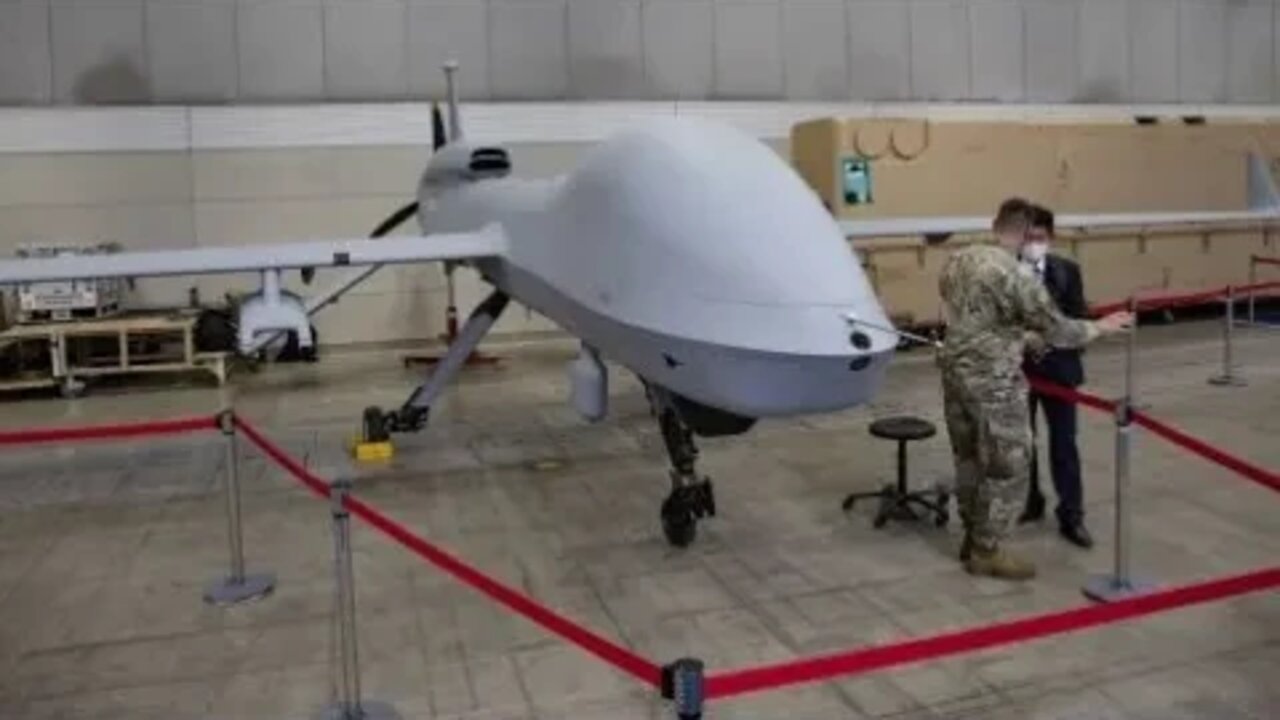Premium Only Content

US studying how to modify powerful armed drone as Ukrainian demand grows.
US studying how to modify powerful armed drone as Ukrainian demand grows.
As Russian forces have retreated in Ukraine's south, the Biden administration has announced a slew of new military aid packages for Ukraine, but all were missing a piece of weaponry that Ukraine's military has long sought: the multi-use Gray Eagle drone, armed with Hellfire missiles.
According to two officials, the US has been looking into modifications that can be made to the deadly drone. Changes that would make the potential of losing any – with their sensitive onboard technology – less of a danger and possibly increase the likelihood of Ukraine receiving them.
There are specific and very technical tweaks and neutering that can be done to these that may make it possible in the nearer term," a congressional official said. "But those things take time and are fairly complex."
A US official confirmed that the Army is leading the efforts to study what changes are possible to the drone, which is made by General Atomics and referred to in the Army as the MQ-1C.
"When you're talking drones, this is about as good as you can get," says Seth Jones, the director of the International Security Program at the Center for Strategic and International Studies. "These are really sophisticated drones."
Without any changes however, the Gray Eagle, which can carry four Hellfire missiles and fly at 25,000 feet for almost 30 hours, would likely not be on upcoming lists of military aid allocated to Ukraine.
There's still real interest in providing this particular system, provided we c
make the necessary modifications and they are still useful to Ukraine on the battlefield," the US official said.
Discussions over the Gray Eagle are ongoing and it has not been ruled out or officially denied to Ukraine, the US official and a Ukrainian official said. The Wall Street Journal previously reported that the Pentagon had declined Ukraine's request.
Ukraine is 'pushing back'
"We are pushing back, we didn't give up," the Ukrainian official said. "This is about survivability [for Ukraine]."
Pentagon spokesman Colonel Roger Cabiness would not comment specifically on the Gray Eagle, saying only that the Department of Defense continues to consult with Ukraine on security assistance.
The White House declined to comment and General Atomics did not respond to a request for comment.
On top of the lethal capability of the missiles it carries, the Gray Eagle would allow Ukrainian forces greater ability to gather intelligence and carry out reconnaissance from farther away, expand the assistance of targeting by artillery on the ground and combat the drones flown by Russia.
Throughout the war, the US has been slow and reluctant to provide Ukraine with dramatically more advanced and longer-range capabilities, like missiles that would allow Ukraine to strike inside Russia and therefore potentially be seen by Moscow as a significant escalation in the conflict.
In the case of the Gray Eagle, a US official argued, the concern is less about escalation than technological security: the potential for the pricey drones to go down in Ukraine and be recovered by the Russians.
"These are very expensive systems and there are concerns that they could be shot down," said the official, declining to say what parts of the drone would be most dangerous if they end up in Russian hands.
It's a scenario that the US has recently been on the receiving end of. After Iranian drones were shot down in Ukraine, the US was able to examine the wreckage, the Washington Post reported.
The US official declined to elaborate on what technology on the Gray Eagle is the most sensitive but said they wouldn't be considered escalatory since similar capabilities are being provided.
The technology in question likely centers on the imaging and intelligence-gathering capabilities and sensors, Jones from CSIS said, adding that he believes US fears are really rooted more in escalating the conflict with Russia.'
"You're really going to fly those pretty far back from the frontlines," he said. "I don't think you'd risk them up close and you wouldn't need them up close because they can fire from a distance and they can collect [intelligence] from a distance."
US has modified weapon systems before
This wouldn't be the first time modifications have been made to US systems to get them to Ukraine. The Wall Street Journal reported in March that classified components were removed from Stinger antiaircraft missiles by simply taking out several screws. That was enough for the US to be able to ship them out.
That's all for now, remember to subscribe to our channel. Subscription is free.
Make sure you Subscribe,Like,Comment and Share.
-
 0:16
0:16
Thoughts TV
11 months agoBeautiful Nigerian lady dancing video
168 -
 1:47:17
1:47:17
Roseanne Barr
10 hours ago $23.89 earnedThe Most Offensive Comic, Leonarda Jonie | The Roseanne Barr Podcast #86
93.6K77 -
 4:17:42
4:17:42
Joker Effect
7 hours agoRumble Community Night. Reviewing Rumble partnership program, it's streamers and community discussion.
61.9K14 -
 2:29:56
2:29:56
Laura Loomer
7 hours agoEP100: MAGA Goes Scorched Earth On USAID
57.6K45 -
 51:45
51:45
Talk Nerdy 2 Us
9 hours ago🔥 Talk Nerdy 2 Us – Feb 7th: HACKED, TRACKED & UNDER ATTACK! 🔥
55.8K4 -
 58:33
58:33
Man in America
15 hours agoFluoride & the Sinister Plot to Poison Us From Birth w/ Larry Oberheu
47.2K21 -
 3:41:30
3:41:30
I_Came_With_Fire_Podcast
16 hours ago🔥USAID SCANDAL | MA-GAZA | Cartel VIOLENCE Ramps Up🔥
56.4K9 -
 7:57:34
7:57:34
SpartakusLIVE
10 hours agoShadow BANNED, but we PARTY ON || Friday Night HYPE
62.9K2 -
 2:00:53
2:00:53
Omar Elattar
8 hours agoGRANT CARDONE: “Will I Run for Governor?” | Trump EXPOSED | Bitcoin | $500 Billion Crisis!
41.3K7 -
 46:48
46:48
Glenn Greenwald
11 hours agoGlenn Takes Your Questions On Gaza, USAID, and More | SYSTEM UPDATE #403
79.6K49